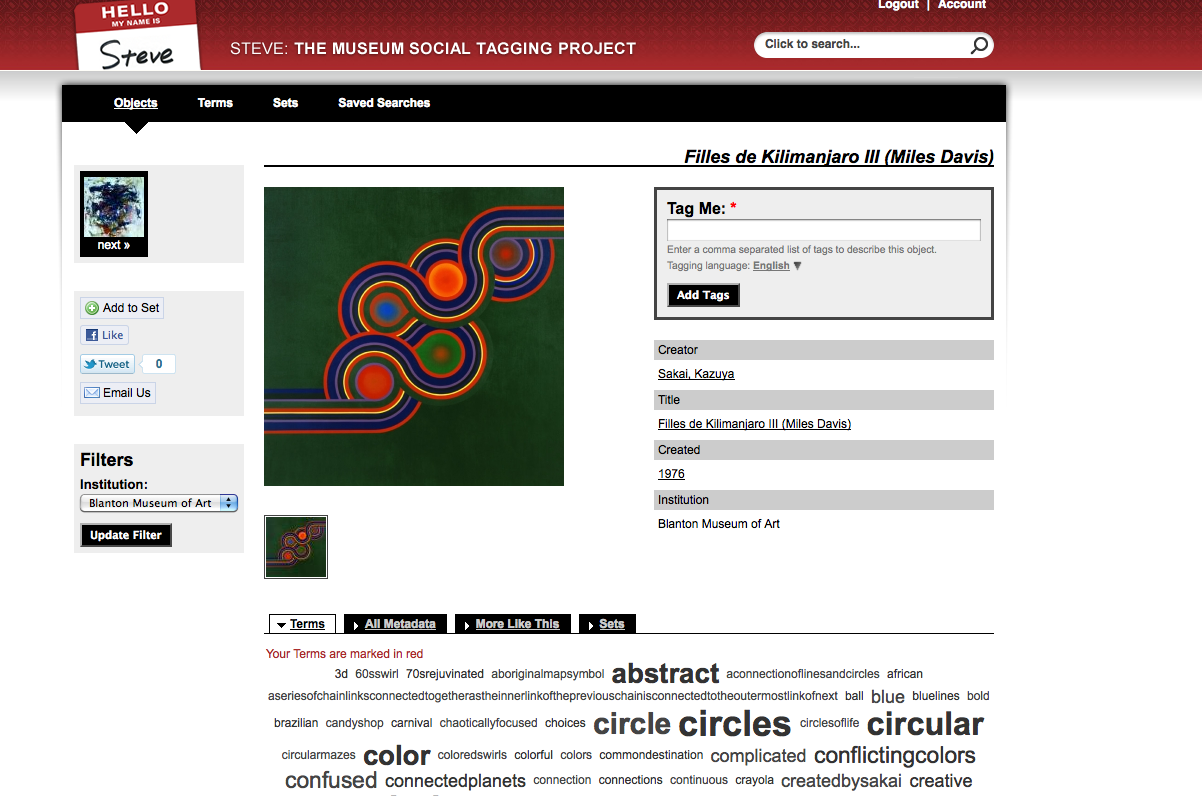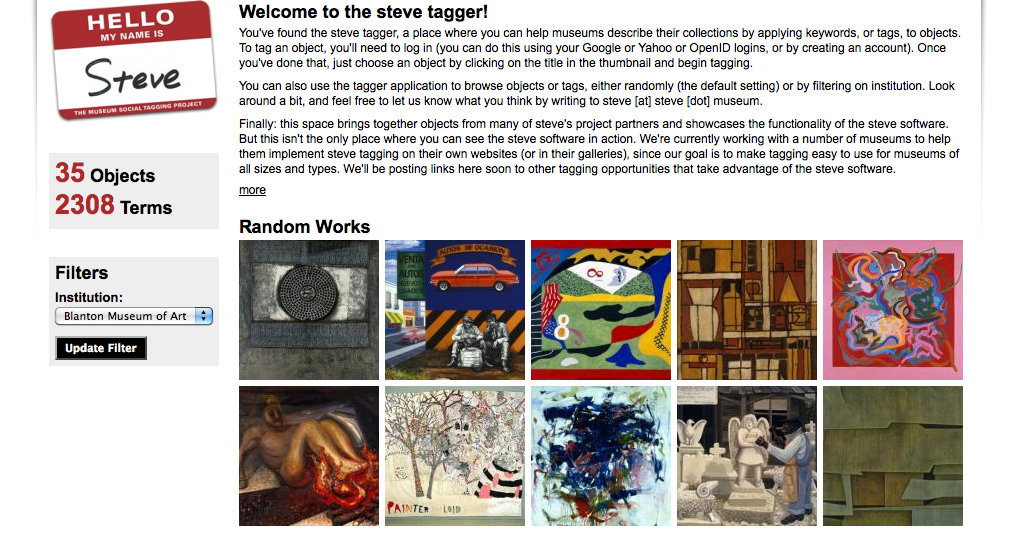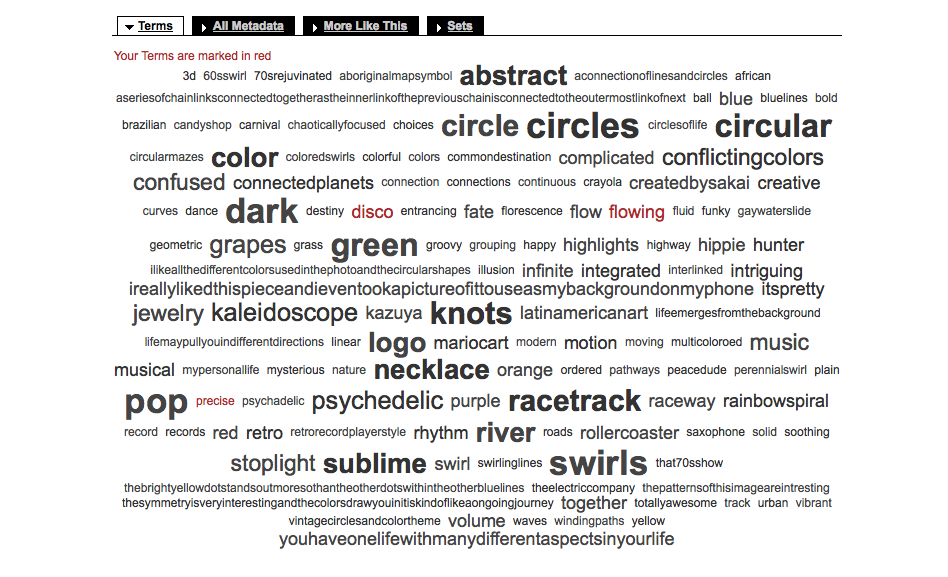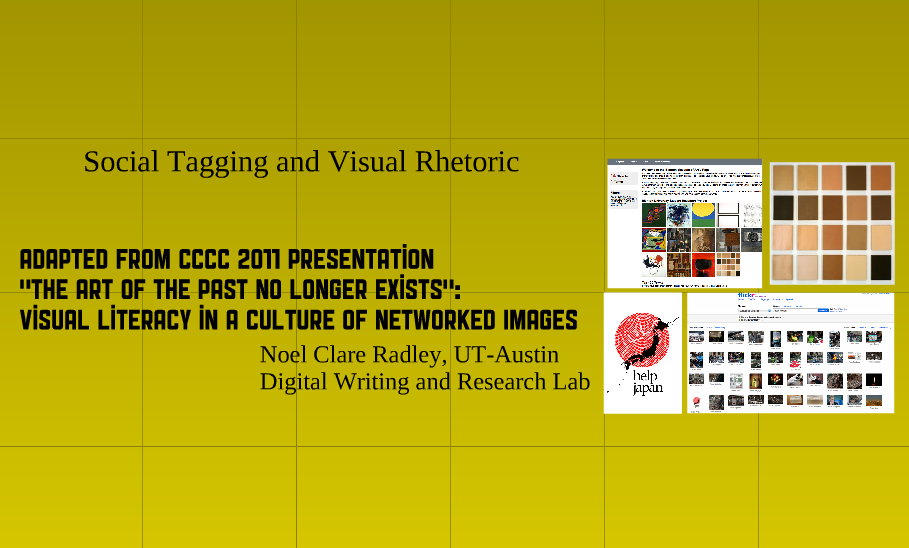
Screen shot of the Blanton STEVE tagger
We have written before about the STEVE in Action project, which helps art museums incorporate tagging interfaces onto their websites in order to encourage thoughtful interaction between the patrons and the art objects. This semester, we used the Blanton's STEVE interface to get a closer look at how students write about abstract art, and while we have not yet processed all the data, the experience has been very thought-provoking.

Screen shot of the Blanton STEVE tagger
We collected data with the help of several instructors in the Digital Writing and Research Labs. Viz members involved with STEVE went to different undergraduate classes to administer the activity. Students were asked to use the STEVE tagger to create tags for various works of abstract art from the Blanton's collection. They also completed surveys before and after tagging. These surveys attempted to gauge the students' attitudes toward abstract art in order to provide additional context for the tags we received. All of the tagging was anonymous and we emphasized that there were no "right answers" so that students would feel more comfortable writing responses. While we did not explicitly frame the tagging experience as social, students could see the tags that other students had produced in a tag cloud at the bottom of the page.

Close up of Tag Cloud for Filles de Killimanjaro
Our rubric for coding the data is borrowed from Jeff Grabill and Stacey Pigg from the WIDE (Writing in Digital Environments) Initiative at Michigan State. They were gracious enough to share their evaluation methods after a discussion of the Take Two Project at Michigan, where they are also considering the impact of web environments on museum learning. The rubric, which is duplicated below. Our partner researchers at the Blanton will looking at this data through the lens of aesthetic development theory (VTS theory), as one coding pass. But we'll use Pigg and Grabill's rubric in another pass, in order to focus on our approach in the Digital Writing and Research Lab to social tagging as a form of writing, and through the lens of rhetoric.
Rubric for Coding Data (Based on Jeff Grabill and Stacey Pigg's "Coding Instructions")
1. Building Ethos (Invoking Role, Place, Education, Status, Values, Affect)
2. Building an Argument (Toulmin model, using Evidence, naming Experts, Logos)
3. Building Community (Indicating previous ideas, Inviting others to comment, Articulation of Shared experience)
4. Exploring New Ideas (Invention)
5. Building Pathos (Using emotions, or subjective experience)**Added to the WIDE rubric by Visual Rhetoric Workgroup UT-Austin

Screenshot of Prezi Presentation Soon Available from "Social Tagging and Visual Rhetoric, viz."
Most analysis of tagging has been conducted in fields of technical writing and information science. Tagging has been defined an activity where users are better able (collectively) to create shared terms to find and return to important information. So, is tagging writing? Of course, yes. Single words or short phrases might not fit the length or format, of traditional argumentation (such as speeches, print publications, or essays). Yet, these words appear in fonts of varying sizes corresponding to a digital image. This interaction of word and image has potentially a richer affective function beyond the tag's function as meta-data. Moreover, it is also important to note that short word tags often are coordinated with hyperlinks to long-form writing in websites, profiles, and forums.
Tags are writing in the strict sense. It is also obvious that tagging is being used as part of persuading and engaging publics in civic discourse. As we move into coding the data from the study, we have a growing sense about what Visual Rhetoric can say about tagging. In the case of Flickr, social tagging collects images together in galleries, juxtaposing diverse, dynamic media. Events such as the Japan tsunami, for example, occasion the creation of tags with which users make visual arguments about nuclear power, humanitarian aid, or even commercial services. These groupings in Flickr indicate the solidarity, among other psychological experiences, that groups of people create via word tags.
The tagging interface and its functionality can influence the type of discourse that emerges. For example, the image sets in the STEVE tagger delimit the images based on museum collections, and thus, they create a situated and controlled experience, one that attempts not merely to create solidarity between users, but between users and the environments of institutional museums. Finally, the kinds of images in the STEVE sets reflect a variety of art collections, images which imply very different responses and audiences. In our partnership with the Blanton, we are looking forward to closely analyzing how people respond to works of contemporary abstraction and what those works have motivated them to write.




Recent comments
2 years 29 weeks ago
2 years 44 weeks ago
2 years 44 weeks ago
2 years 50 weeks ago
3 years 4 weeks ago
3 years 4 weeks ago
3 years 4 weeks ago
3 years 6 weeks ago
3 years 6 weeks ago
3 years 6 weeks ago